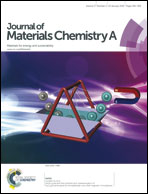Novel SCR catalyst with superior alkaline resistance performance: enhanced self-protection originated from modifying protonated titanate nanotubes
Abstract
In this paper, ion-exchangeable titanate nanotubes were synthesized with a treatment of ethanol washing (referred to as TNTs-eth), which were utilized as supports for ceria (CeO2) catalysts. The resulting catalysts showed excellent resistance to alkali metal and alkaline earth metal poisoning in NH3-SCR applications, where the NO conversions could be maintained at 97%, 88% and 95% (at 350 °C) when Na+, K+ and Ca2+ were added, respectively. After the catalysts were subjected to a range of analyses, it was found that the resistance was mainly attributed to the significant increase in structural ion-exchangeable OH groups in the TNTs-eth catalyst, which led to a remarkable surface acid strength and abundant acid content, effectively neutralizing the basicity induced by the alkali metals and alkaline earth metals and retaining the SCR performance. Moreover, the repeatable Ce4+/Ce3+ redox cycles and the well-maintained nano-tubular structure also accounted for the excellent resistance performance of the Ce/TNTs-eth catalyst. We expect that the self-protection effect of the Ce/TNTs-eth catalyst (that was induced by its ion exchange ability) might provide a novel approach for the design and synthesis of SCR catalysts to relieve their alkali metal and alkaline earth metal poisoning.


 Please wait while we load your content...
Please wait while we load your content...